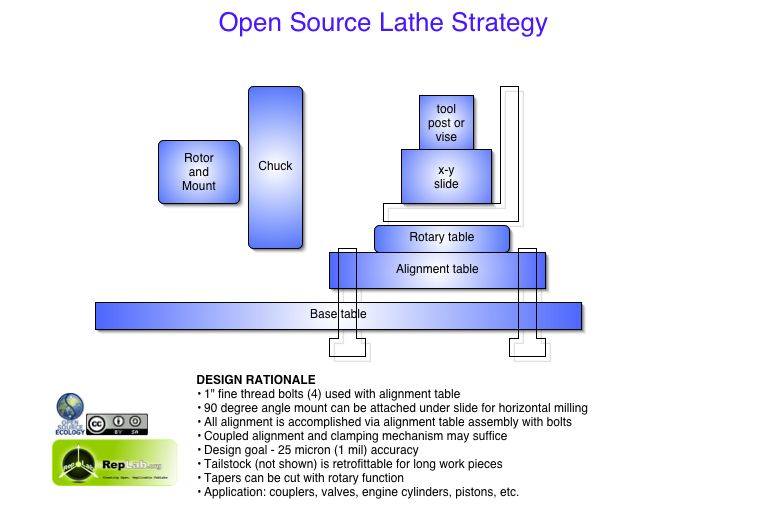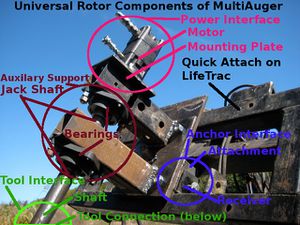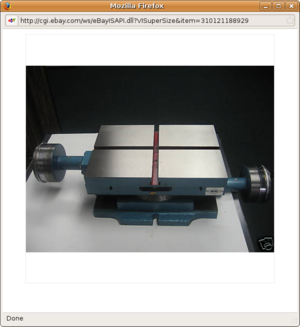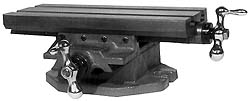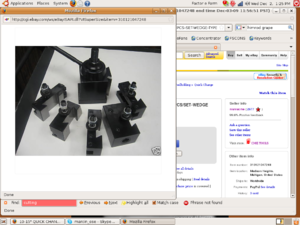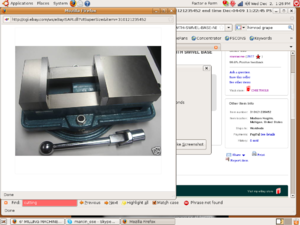Lathe Build
Concept
You can see previous work at Lathe - which is now being modified for a shortbed version, and complete modularity by addition of slide tables, clamps, and compounding of slide tables for mill-drill-lathe option on a horizontal machine. The lathe will use a rotor from the LifeTrac infrastructure, and it will be attachable to an existing flat surface, such as our 4x8 foot, 1/2" thick welding table.
- Previous work - Lathe
- Blog post on the build - [1]
- This work is an attempt at a replicable version of the Multimachine
Introduction
Read this beautiful introduction on the practical aspects of a lathe in this introduction by a master of documentation, Chris Palmer - [2]
Auger
Ben,
So here's my plan right now. Use a hydrauilic fixture with 20 hp that can be fixed to a table readily. This is what I have already on LifeTrac - a stiff auger mechanism:
Bill of Materials
Here is the bill of materials:
Lathe
Is it possible to convert the auger to a lathe? Sure. Take a chuck from here.
Add a slide from Enco. See review
- Better compound cross slide, .001 accuracy: eBay at $160 plus shipping:
Spec
What are the needs?
- Basic applications are couplers, hydraulic valve stems, and steam engine cylinders and pistons. Basic shortbed work on small workpieces. To be scaled up to a 2000 lb xy slide down the road for more efficient turning, with modifications as we go along.
- Length, diameter of object? 1 foot long up to 12 inch pipe
- Tolerances, including surface finish? 25 micron
- Manual or CNC? Manual at first, retrofit later.
- Material to be turned? Mild steel and aluminum.
- RPM range? 0-700 RPM
Danger
20HP at low rpm involves HUGE forces. This is going to be seriously dangerous because many of the possible failures would be catastrophic and faster than a human operator can react. Much smaller lathes cause fatal accidents from time to time. Breakage of the tool support or failure of the workholding would quite likely lead to big bits of metal flying about. Extreme caution is justified.
The proposed XY table is not intended to support anywhere near the max load that the hydraulics can apply. Most cast iron will fail fast (shatter).
A much smaller version may be a rewarding use of time to prove the design at reduced scale, cost, risk of failure, and danger of fatal or crippling injury.
Comments
- The entire system is non-optimized. It is a generalized system that optimized interchangeability of parts and multipurpose performance, not specific performance. The critical distinction is sufficiency vs. optimization. Performance can be optimized by further interchangeability. This is not a finished product, but an item that works for intended applications of milling motor couplers and boring steam engine cylinders.
- 20HP is max. It can be run from 1-20 hp.A 20 HP accident is no more fatal than a 1 HP and accident when it comes to machine vs. delicate human.
- XY table is absolutely too weak, but it is sufficient and cheap. Other suggestions are welcome.
- Marcin has significant experience regarding failure modes and behavior characteristics of hyraulics. Not an issue.
Materials, Rigidity
Pro lathes are usually made of the fewest thickest possible pieces of cast iron, for rigidity and damping. If mild steel box and sheet, bolted or welded, was good enough then there would probably be examples out there (If it's easy and cheaper and the Chinese won't do it then it probably doesn't work). There are substantial risks that the lathe will work poorly or not at all unless it is small and made of very thick stock. If any machine tool is insufficiently rigid then the cutting edge chatters on the work piece, giving a bad finish, rapid heating of the tool, and rapid tool failure. Also, cutting forces cause the machine to elastically distort, quickly introducing very large errors.
Without defining the spec, it is difficult to design. Materials for machine tool frames include
- Aluminium alloy, on small cheap low precision or soft material tools
- Cast Iron, on most machines. Well proven.
- Synthetic or real Granite, on super precision moderate mechanical load machinery
Synthetic granite is made from ~80% granite powder with an epoxy binder, and has ~9x better damping than cast iron but much lower tensile strength. (I'd like to experiment with machine tools made from a synthetic granite modified with chopped strand carbon fibre, but that's an unproven material. Leo.dearden)
Synthetic Granite
- What are costs of raw materials?
- Where do we get them?
Cross Slide
- What are options for an off-shelf cross slide?
- What are accuracy limits of simple cross slides made from cold rolled steel, 3/4 inch fine nuts and bolts, where nuts are pretensioned to minimize backlash? Is this a simple, robust solution that can reduce backlash to 25 microns?
- Are there any good DIY solutions for precision cross slides?
Collaborators
Review
Sam Putnam
First comment would be that you're proposing to build a Type 1 replicator, which can be set up with additional jigs and fixtures for Type 2 replication. :-)
Second comment would be this:
That's a 19-year-old CNC lathe for a hundred bucks. Granted that it was probably broken, but a broken lathe is almost always a much simpler and cheaper platform than a brand-new lathe. If you watch ebay long enough, you will find another.
Now, you probably need a lathe pretty badly regardless, and a Type 3 lathe is a CNC screw machine with quick-change tool head and workpiece feed at a bare minimum, so there's no reason you shouldn't get or develop yourself a Type 1 lathe for Factor E. It would be awesome if such a design incorporated the idea of eventually adding enough modular components that the lathe would qualify as a CNC screw machine.
Moving on to the design you've shown. It's not especially specific but I see several things that concern me. One is that you seem to be coupling your hydraulic motor directly to the spindle and headstock. Normally one isolates the motor with a pulley to prevent vibration from traveling along the shaft. That's easy enough to fix.
The poured-concrete bed will shrink on you, but you can compensate for that effect with gibs. Does your design have gibs? I couldn't tell. Using a single piece of round stock as a ways is going to enthusiastically bugger your accuracy as soon as you go off center, and possibly send the toolpost flying. Would you consider a couple pieces of round stock or T-slot instead? An extruded ways will probably be simpler/cheaper than cold-rolled steel or scraped bronze or cast iron, and it matches our emerging design pattern language.
BTW a design based on a cast concrete bed isn't maximally portable. Some of us live in subduction zones and high Richter events have a way of cracking monolithic concrete!
For good generality in a CNC lathe, one needs travel along the carriage and cross-slide, plus rotation of the tool angle, making for two Cartesian coordinates and one polar. The carriage and cross slide can be simple lead-screw drives and rotary tables are usually built with a worm drive. If one wants milling capacity on the same machine, a Z axis is needed, but for a Type 3 lathe there are two additional fittings (at least): a robot that feeds workpieces into the chuck and a quick-change toolhead. That would make it inconvenient to mill on the same machine one lathes with; it is widely said to be inconvenient in any case. A mill spins the toolhead while a lathe spins the workpiece: the two tasks are different enough to benefit greatly from two dedicated machines.
Concluding comment would be: work with the OpenLathe people, they know a whole hell of a lot. If you join the googlegroup you'll have access to a grip of files with a ton of revelant and useful information. Hope this helps.
Ben Lipkowitz
the rotary table is silly. you ain't gonna need it. the tool post has to be below the centerline, and the rotary table eats up valuable vertical distance.
you should use three points for alignment instead of four. don't make me crawl under the table to loosen the bolts; they should thread into nuts welded under the table and be locked with jamb nuts on the top side. actually, shims would be better: more rigid and compact.
i hope your "base table" is thicker than the two inches in the above diagram. a plain steel bed won't work because it has no damping, and sam doesn't like concrete for some reason (earthquakes, really?) so how about "polymer concrete" - just epoxy mixed with granite aggregate and powder. "it's what the pro's use." anyway, concrete machine tools were very common during WWII and during reconstruction in germany. they can be quite beautiful actually: http://www.epucret.de/en/products-solutions/product-overview/cast-parts/ http://www.epucret.de/en/products-solutions/product-overview/accuracy/
if i were building a huge lathe to be portable, i'd use a big rectangular tube of structural steel and pack it full of gravel and something viscous like wet bentonite clay or heavy oil.
the original "guide rail" is awful, and two of them would be only slightly less awful. you need full support under the carriage at every point along its travel. that floating bar will flex like mad in the center. for most CNC tasks you tend to do small stuff, so the little XY table might be sufficient on its own, bolted directly to the bed, then unbolted and moved around for doing bigger stuff. speaking of CNC, one huge problem is that there's no spindle through hole, so you can't use a bar feeder.
if you're going to be doing end milling with the angle plate, make sure to size the carriage much wider than it needs to be for lathe work, at least twice as wide as the distance from bed to centerline. also, it has to be mounted to the top side of the XY table.
I suggest making some toy models out of wood or foam or whatever you have lying around.
Leo Dearden
The design is a little unclear (because it is incomplete, as it should be at this stage), so I may be misunderstanding a few points.
From http://openfarmtech.org/index.php?title=Lathe_Build and from the blog post, I believe that you are planning to use a welding table as your lathe bed, and bolt the auger and a cheap manual XY drill press table to it. Once you have a chuck on the auger spindle, v1 is done. Is this about right?
If so, then I have these major misgivings:
Accuracy:
You are aiming for 25um accuracy. There are many sources of error and I think that will be very hard. Below are the major challenges as I see them. Perhaps you'll be happy with less precision? It's possible that I'm wrong about how hard it is, and I'd like to be pleasantly surprised. :-)
Tools:
Do you have any of: micrometer, machinist's level, engineers square, dial gauge? Without precision instruments you will be guessing. If you can't measure an error it's almost impossible to correct it.
Alignment:
Getting the axies of the XY table lined up with the axis of auger spindle in both vertical and horizontal directions will be hard. If your total error budget is 25um then you can't afford much misalignment. Even if the bolt holes are 'tight' and they're in 'exactly' the right place, bolts aren't better than +-50um in diameter: they aren't really meant to align, just fasten. Pins in reamed holes are an alignment fixture, but I don't know how you would get the holes in the right place. Possibly you could drill oversize bolt holes, drill and ream one pin hole, do rotation to get alignment in the horizontal plane, tighten-measure-loosen-shim for vertical alignment, and then drill and ream the other holes with the parts bolted down.
Every time you remove and replace a part the process will have to be partially repeated, at best to restore the vertical alignment.
Creep:
Steel that hasn't been stress relieved since it was last welded, rolled, or extruded, tends to flex and warp with time and temperature. By the accounts on CNCzone that will be plenty to blow your error budget.
Vibration:
Steel is springy. This means that it is a poor vibration damper. Especially with a single sheet of relatively thin sheet steel as the lathe bed, you'll have a great deal of vibration. That's very hard on the tool, and bad for accuracy. You can suck it and see, and if there is too much vibration, you could back the whole table with Epoxy Concrete (see http://en.wikipedia.org/wiki/Epoxy-granite or http://www.cnczone.com/forums/showthread.php?threadid=30155 for good discussions).
Bottom line, this is a product in itself.
a quick-change toolhead. That would make it inconvenient to mill on the same machine one lathes with; it is widely said to be inconvenient in any case. A mill spins the toolhead while a lathe spins the workpiece: the two tasks are different enough to benefit greatly from two dedicated machines.
Seconded.
Concluding comment would be: work with the OpenLathe people, they know a whole hell of a lot. If you join the googlegroup you'll have access to a grip of files with a ton of revelant and useful information. Hope this helps.
Seconded.
Ben 2
On Wed, 25 Nov 2009, Leo Dearden wrote:
Getting the axies of the XY table lined up with the axis of auger spindle in both vertical and horizontal directions will be hard. If your total error budget is 25um then you can't afford much misalignment. Even if the bolt holes are 'tight' and they're in 'exactly' the right place, bolts aren't better than +-50um in diameter: they aren't really meant to align, just fasten.
real machine tools tend to favor exactly this sort of "software based" adjust mechanism. you tighten a bit, measure a bit, tap with a tiny hammer, and repeat to your satisfaction. alignment pins will wear out, get sloppy, get bent when you crash the tool into the chuck, and have a certain amount of built-in alignment error.
with good collets and a perfectly straight test bar you can traverse a dial test indicator in the toolpost along the test bar.
here is a good description of how to align the spindle and ways even when everything is totally fubar: http://web.archive.org/web/20021029114727/http://www.john-wasser.com/NEMES/RDMLatheAlignment.html
of course for a quick one-off tractor bushing or whatever you might just as well do it by eye with a straightedge mounted in the toolpost.
vertical alignment doesn't matter as much because you are dealing with cosine error instead of linear error. one inch of vertical alignment error causes less than one inch of error along the diameter. if your carriage travels along a vertical diagonal it will cut a hyperboloid instead of a cylinder. make sense?
remember that maintaining +-25 microns over 1 m is 100 times more difficult than over 1 cm; conversely if you want to impress intelligent people you have qualify that statement of precision a little better.
Steel that hasn't been stress relieved since it was last welded, rolled, or extruded, tends to flex and warp with time and temperature. By the accounts on CNCzone that will be plenty to blow your error budget.
seconded
instead of welding, a "professional" way to build machine frames is called "grouting" in which the frame pieces are bolted together with epoxy (moglice) smooshed in between the bolted joints. this provides a joint that's strong enough for machine tools but won't warp or shift around under vibration.
i don't think the welding warpage matters too much with the current design of a bolt-on cast iron XY table, but it's something to keep in mind if you are contemplating changes.
Sam 2
Good collets and spindles, and a well-aligned headstock, are non-optional. Any wobble here can't be compensated for.
I've been wondering about the larger alignment issues, though. Building a straight carriage is one thing, and extrusion works well. Keeping it in perfect alignment with the headstock given the forces acting on it, that's tricky. Even getting it into alignment is a bit of an art, little hammers, shims, gibs, dial indicators...
What about laser alignment and software correction? Assuming for a moment we just have Y along the carriage and X along the slide, picture a laser that is chucked into an auto-centering 3 jaw and used to fix alignment in the carriage and cross slide by adding X and Y movements to nominally Y and X travel. This would reduce or eliminate all but the cosine errors you refer to, which could be compensated in a similar manner.
I'm increasingly favoring some sort of composite-filled T-slot extrusion, which is easy to get into two or three nines of alignment. I wonder if we could get four or five nines with software, and save our time for other tasks that don't involve weensy hammers.
The best part of this would be recalibrating for wear without messing with gibs and shims. Re-chuck your laser and run the calibration software again.
Is this feasible? Would the process introduce aliasing that would have to be compensated for or just leave small finish marks that would generally not effect function? It seems worth trying.
